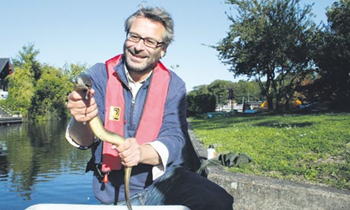The decline of the eel in Britain
There are six of them, writhing lazily at the bottom of Darryl Clifton-Dey’s plastic tank. “Weird” doesn’t, frankly, do them justice: small, beady eyes; big ugly snout. Sinuous, slimy; even on a sunny morning on the banks of the Thames, faintly sinister. Beasts of legend and bad dreams. Even lightly sedated, one half-hearted wriggle and they slide effortlessly out of your grasp, a powerful ripple of grey-green and silver. Their skin is extraordinary, like liquid velvet. … One thing, though, we do know: the elvers, or young eels, that once wriggled their way up Britain’s rivers in such multitudes that on the Thames alone, as one author wrote in 1902, “they made a black margin to the river, on either side of the banks”, have stopped coming. Scientists estimate that across Europe, elver numbers have now crashed to barely 5% of their 1980s levels. With no action, it’s feared, in 20 or 30 years there may be no adult eels left either. The European eel, anguilla anguilla, is the subject of urgent legislation in Brussels; it’s an endangered species, and member states are required to take immediate steps to protect it. … No one knows exactly why glass eel numbers have plummeted. It could be to do with slight shifts in the Gulf Stream’s direction: the baby eels may be getting swept past us. Or it could be changes in its temperature. The eels’ wetland habitat has also shrunk down the years, and a parasite is playing havoc with their swim bladders, affecting their ability to move up and down through the ocean’s layers. Perhaps a buildup of pesticides in their bodies means the adult eels are not as fit as they were when they spawn. What is certain, says Adam Piper, who is doing an agency-funded PhD on eel behaviour, is that a growing number of increasingly impermeable man-made structures on Britain’s rivers are making their journeys harder. “Look at what they face now,” Piper says: “Weirs, locks, sluices, pumping stations. All built of concrete and steel, not leaky wood. Anything hydraulic is a disaster; turbines just chop them up.” Piper is working on how eels cope with different types of barrier, and why they choose one route over another. “They seem to be seeking out a path,” he says, “not just going with the flow.” …
